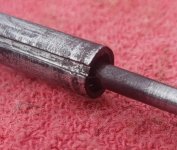Here are a couple pictures of the cylinder parts from K80333, a gun that is identical to yours. The first picture shows the upper half of the extractor rod, the center pin, and the rear face of cylinder.

On the left is the extractor rod. On the threaded end, you can see how much metal is trapped in the lower half of the rod. It's 5/8" total, from its end to the shoulder on the rod. Right now, you can't get to it, because the center pin is in the way.
The element in the middle of the picture is the center pin. You'll notice the ring on it, which serves two purposes. First it limits the downward travel of the center pin, and second it acts as a base for the spring that is around the center pin. That spring is compressed by the end of the top half of the extractor rod, causing the pin to move downward to retain the cylinder when it is closed. Right now, the ring and that spring are preventing you from pulling the center pin out of the bottom half of the extractor rod, because the spring is being compressed by the broken end of the top half of the extractor rod, and the ring.
The next picture is a closeup of the extractor star.

You can see the two red lines going into the spanner slots on the center piece of the extractor star. That center piece unscrews, using a small spanner wrench (two spanner pins go into those two slots) . It has a standard right-hand thread, so it loosens to the left.
If you can get it out, you might, or maybe not, be able to pull the center pin out of the lower half of the extractor star. If not, then the extractor star does come off the extractor rod. Gary Lowe had that center piece come loose, and when he removed it, the extractor star itself came off, either by unscrewing it, or by lifting it, from the extractor rod.
It's important that you get the lower half itself pulled through the bottom of the cylinder, so that you can work on it. There is a very small finger-like projection, that is fragile, and is located in the bottom of the cylinder. It's the positioning guide for the extractor lower rod. Don't break that finger!
If you are unable to make this work, in removing the center pin, for whatever reason, then I have one more suggestion.
If you can pull the center pin forward far enough, so the its internal spring is completely compressed, and then cut it off as close as possible to the top of the lower half of the extractor rod, you can get yourself some working room, to try to remove the broken end of the top half of the rod.
Hope some of this helps.
Regards, Mike Priwer

On the left is the extractor rod. On the threaded end, you can see how much metal is trapped in the lower half of the rod. It's 5/8" total, from its end to the shoulder on the rod. Right now, you can't get to it, because the center pin is in the way.
The element in the middle of the picture is the center pin. You'll notice the ring on it, which serves two purposes. First it limits the downward travel of the center pin, and second it acts as a base for the spring that is around the center pin. That spring is compressed by the end of the top half of the extractor rod, causing the pin to move downward to retain the cylinder when it is closed. Right now, the ring and that spring are preventing you from pulling the center pin out of the bottom half of the extractor rod, because the spring is being compressed by the broken end of the top half of the extractor rod, and the ring.
The next picture is a closeup of the extractor star.

You can see the two red lines going into the spanner slots on the center piece of the extractor star. That center piece unscrews, using a small spanner wrench (two spanner pins go into those two slots) . It has a standard right-hand thread, so it loosens to the left.
If you can get it out, you might, or maybe not, be able to pull the center pin out of the lower half of the extractor star. If not, then the extractor star does come off the extractor rod. Gary Lowe had that center piece come loose, and when he removed it, the extractor star itself came off, either by unscrewing it, or by lifting it, from the extractor rod.
It's important that you get the lower half itself pulled through the bottom of the cylinder, so that you can work on it. There is a very small finger-like projection, that is fragile, and is located in the bottom of the cylinder. It's the positioning guide for the extractor lower rod. Don't break that finger!
If you are unable to make this work, in removing the center pin, for whatever reason, then I have one more suggestion.
If you can pull the center pin forward far enough, so the its internal spring is completely compressed, and then cut it off as close as possible to the top of the lower half of the extractor rod, you can get yourself some working room, to try to remove the broken end of the top half of the rod.
Hope some of this helps.
Regards, Mike Priwer
Last edited:



